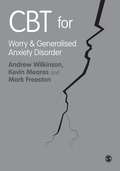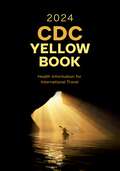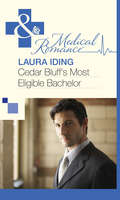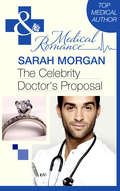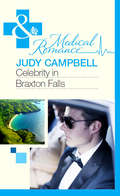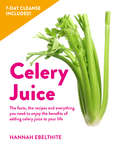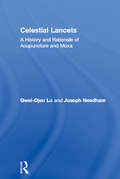- Table View
- List View
CBT for Worry and Generalised Anxiety Disorder (PDF)
by Mark Freeston Andrew Wilkinson Kevin MearesThis practical introduction helps trainees use cognitive behavioural therapy to assess and treat generalised anxiety disorder (GAD), one of the most commonly presented client issues. Taking the reader step-by-step through each stage of CBT with anxiety and worry, the authors illustrate the whole range of different treatment techniques whilst keeping the book accessible and concise. Tailored to current High and Low Intensity (IAPT) training, it covers self-help literature as well as traditional one-to-one therapy. The book: - contains illustrative case material, balancing an evidence-based approach with awareness of the realities of today's practice - alerts trainees to the potential complicating factors and the co-existence of other anxiety or mood disorders alongside GAD - addresses cross-cutting professional themes, such as working with morbidity and the pressures of working within NHS settings. Bridging the gap between theory and practice, this book is essential reading for all CBT trainees on IAPT programmes, as well as trainees on postgraduate counselling, psychotherapy and clinical psychology courses. Qualified therapists who require an update in this area will also find this a useful resource.
CCN proteins in health and disease: An overview of the Fifth International Workshop on the CCN family of genes
by Annick Perbal Masaharu Takigawa Bernard PerbalThe CCN family of genes currently comprises six secreted proteins (designated CCN16 i.e., Cyr61/CCN1; ctgf/CCN2; Nov/CCN3; WISP1/CCN4; WISP2/CCN5, and WISP3/CCN6) showing a strikingly conserved primary structure, with four modules sharing partial identity with IGF binding proteins, Von Willebrand protein, thrombospondin and several matricellular proteins and growth factors. The current view is that CCN proteins modulate signaling pathways that involve regulatory components of the extracellular matrix. As such, they likely act as a central hub in the regulation of mitosis, adhesion, apoptosis, extracellular matrix production, growth arrest and migration of multiple cell types. The 5th international workshop on the CCN family of genes, that was held in Toronto in 2008 brought together scientists from around the world who have an interest in the biological roles of this emerging family of proteins. On an educational point of view, the workshop was a unique place for an efficient diffusion of scientific information. The present book comprises a series of selected manuscripts that are based on the original communications that were presented at the meeting by worldwide leaders in the field of CCN biology. All major aspects of CCN proteins biology in both normal and pathological conditions are covered in this volume, from structure-functions analysis up to the involvement of CCN proteins in complex physiological functions. In addition to reports that support the Yin-Yang concept of CCN proteins driving opposite effects on the same biological process, this book also comprises several contributions that point to CCN proteins as amenable targets for therapeutic manipulation of disease processes. Together with the special issue of Journal of Cell Communication and Signaling in which authors have extended on the original data presented at the meeting, the present Proceedings provide an instant picture and unique update of the state of the art in the CCN field.
CD137 Pathway: Immunology and Diseases
by Lieping ChenThe most practical and clinical reasons for attempting to understand the immunology of infections and disease revolves around the CD137 and CD137/41BB receptor and ligand molecules. This book covers all aspects of CD137/4-1BB pathway research from microbiology, infectious disease, molecular biology, biochemistry, and genetics to immune responses and potential applications in the diagnosis and treatment of human diseases. This pathway is emerging as one of the most important targets for manipulation of immune responses for disease diagnosis and treatment. This book is written by the man who discovered the CD-137 and B7H1 molecules in 1999.
CD4+CD25+ Regulatory T Cells: Origin, Function and Therapeutic Potential (Current Topics in Microbiology and Immunology #293)
by B. Kyewski Elisabeth Suri-PayerThe CD4 Molecule: Roles in T Lymphocytes and in HIV Disease (Current Topics in Microbiology and Immunology #205)
by Dan R. LittmanDuring the late 1970's the application of hybridoma technology led to an explosion in the discovery and characterization of proteins expressed at the surface of hematopoietic cells. The understanding of T lymphocyte biology benefited enormously from this advance and from newly developed techniques for obtaining clonal T cells. Application of these methodologies resulted in the identification of the clonally restricted T cell antigen receptors (TCRs) and of a number of other molecules expressed more broadly on T cells. Among these, the CD4 and CD8 glycoproteins stood out because they were differentially expressed on distinct functional subsets of T lymphocytes. Moreover, blocking studies with monoclonal antibodies sug gested a functional role for CD4 and CD8 in T cell responses to antigen. Shortly thereafter, it was shown that T helper cells were the primary targets for the human immunodeficiency virus (HIV) and that CD4 serves as the viral receptor on these cells. These findings fueled an intense interest in CD4 during the last decade, in the hope that understanding the molecular nature of the HIV-CD4 interaction could hold the key to controlling AIDS.
The CDA TM book
by Keith W. BooneThe CDA book provides clear and easy to use guidance to implement the standard, with numerous examples covering many of the nuances of the standard. Readers can learn not only how to implement healthcare IT using the CDA standard, but to "speak" in the language of the standard, and to understand its idioms.
The CDC Field Epidemiology Manual
A NEW AND ESSENTIAL RESOURCE FOR THE PRACTICE OF EPIDEMIOLOGY AND PUBLIC HEALTH The CDC Field Epidemiology Manual is a definitive guide to investigating acute public health events on the ground and in real time. Assembled and written by experts from the Centers for Disease Control and Prevention as well as other leading public health agencies, it offers current and field-tested guidance for every stage of an outbreak investigation -- from identification to intervention and other core considerations along the way. Modeled after Michael Gregg's seminal book Field Epidemiology, this CDC manual ushers investigators through the core elements of field work, including many of the challenges inherent to outbreaks: working with multiple state and federal agencies or multinational organizations; legal considerations; and effective utilization of an incident-management approach. Additional coverage includes: · Updated guidance for new tools in field investigations, including the latest technologies for data collection and incorporating data from geographic information systems (GIS) · Tips for investigations in unique settings, including healthcare and community-congregate sites · Advice for responding to different types of outbreaks, including acute enteric disease; suspected biologic or toxic agents; and outbreaks of violence, suicide, and other forms of injury For the ever-changing public health landscape, The CDC Field Epidemiology Manual offers a new, authoritative resource for effective outbreak response to acute and emerging threats. *** Oxford University Press will donate a portion of the proceeds from this book to the CDC Foundation, an independent nonprofit and the sole entity created by Congress to mobilize philanthropic and private-sector resources to support the Centers for Disease Control and Prevention's critical health protection work. To learn more about the CDC Foundation, visit www.cdcfoundation.org.
CDC FIELD EPIDEMIOLOGY MANUAL C
by Sonja A. Rasmussen and Richard A. GoodmanA NEW AND ESSENTIAL RESOURCE FOR THE PRACTICE OF EPIDEMIOLOGY AND PUBLIC HEALTH The CDC Field Epidemiology Manual is a definitive guide to investigating acute public health events on the ground and in real time. Assembled and written by experts from the Centers for Disease Control and Prevention as well as other leading public health agencies, it offers current and field-tested guidance for every stage of an outbreak investigation -- from identification to intervention and other core considerations along the way. Modeled after Michael Gregg's seminal book Field Epidemiology, this CDC manual ushers investigators through the core elements of field work, including many of the challenges inherent to outbreaks: working with multiple state and federal agencies or multinational organizations; legal considerations; and effective utilization of an incident-management approach. Additional coverage includes: · Updated guidance for new tools in field investigations, including the latest technologies for data collection and incorporating data from geographic information systems (GIS) · Tips for investigations in unique settings, including healthcare and community-congregate sites · Advice for responding to different types of outbreaks, including acute enteric disease; suspected biologic or toxic agents; and outbreaks of violence, suicide, and other forms of injury For the ever-changing public health landscape, The CDC Field Epidemiology Manual offers a new, authoritative resource for effective outbreak response to acute and emerging threats. *** Oxford University Press will donate a portion of the proceeds from this book to the CDC Foundation, an independent nonprofit and the sole entity created by Congress to mobilize philanthropic and private-sector resources to support the Centers for Disease Control and Prevention's critical health protection work. To learn more about the CDC Foundation, visit www.cdcfoundation.org.
CDC Yellow Book 2018: Health Information for International Travel
by Centers for CDCTHE ESSENTIAL WORK IN TRAVEL MEDICINE -- NOW COMPLETELY UPDATED FOR 2018 As unprecedented numbers of travelers cross international borders each day, the need for up-to-date, practical information about the health challenges posed by travel has never been greater. For both international travelers and the health professionals who care for them, the CDC Yellow Book 2018: Health Information for International Travel is the definitive guide to staying safe and healthy anywhere in the world. The fully revised and updated 2018 edition codifies the U.S. government's most current health guidelines and information for international travelers, including pretravel vaccine recommendations, destination-specific health advice, and easy-to-reference maps, tables, and charts. The 2018 Yellow Book also addresses the needs of specific types of travelers, with dedicated sections on: · Precautions for pregnant travelers, immunocompromised travelers, and travelers with disabilities · Special considerations for newly arrived adoptees, immigrants, and refugees · Practical tips for last-minute or resource-limited travelers · Advice for air crews, humanitarian workers, missionaries, and others who provide care and support overseas Authored by a team of the world's most esteemed travel medicine experts, the Yellow Book is an essential resource for travelers -- and the clinicians overseeing their care -- at home and abroad.
CDC Yellow Book 2018: Health Information for International Travel
by Centers for CDCTHE ESSENTIAL WORK IN TRAVEL MEDICINE -- NOW COMPLETELY UPDATED FOR 2018 As unprecedented numbers of travelers cross international borders each day, the need for up-to-date, practical information about the health challenges posed by travel has never been greater. For both international travelers and the health professionals who care for them, the CDC Yellow Book 2018: Health Information for International Travel is the definitive guide to staying safe and healthy anywhere in the world. The fully revised and updated 2018 edition codifies the U.S. government's most current health guidelines and information for international travelers, including pretravel vaccine recommendations, destination-specific health advice, and easy-to-reference maps, tables, and charts. The 2018 Yellow Book also addresses the needs of specific types of travelers, with dedicated sections on: · Precautions for pregnant travelers, immunocompromised travelers, and travelers with disabilities · Special considerations for newly arrived adoptees, immigrants, and refugees · Practical tips for last-minute or resource-limited travelers · Advice for air crews, humanitarian workers, missionaries, and others who provide care and support overseas Authored by a team of the world's most esteemed travel medicine experts, the Yellow Book is an essential resource for travelers -- and the clinicians overseeing their care -- at home and abroad.
CDC Yellow Book 2020: Health Information for International Travel
by Centers for (CDC)The definitive reference for travel medicine, updated for 2020! "A beloved travel must-have for the intrepid wanderer." -Publishers Weekly "A truly excellent and comprehensive resource." -Journal of Hospital Infection The CDC Yellow Book offers everything travelers and healthcare providers need to know for safe and healthy travel abroad. This 2020 edition includes: · Country-specific risk guidelines for yellow fever and malaria, including expert recommendations and 26 detailed, country-level maps · Detailed maps showing distribution of travel-related illnesses, including dengue, Japanese encephalitis, meningococcal meningitis, and schistosomiasis · Guidelines for self-treating common travel conditions, including altitude illness, jet lag, motion sickness, and travelers' diarrhea · Expert guidance on food and drink precautions to avoid illness, plus water-disinfection techniques for travel to remote destinations · Specialized guidelines for non-leisure travelers, study abroad, work-related travel, and travel to mass gatherings · Advice on medical tourism, complementary and integrative health approaches, and counterfeit drugs · Updated guidance for pre-travel consultations · Advice for obtaining healthcare abroad, including guidance on different types of travel insurance · Health insights around 15 popular tourist destinations and itineraries · Recommendations for traveling with infants and children · Advising travelers with specific needs, including those with chronic medical conditions or weakened immune systems, health care workers, humanitarian aid workers, long-term travelers and expatriates, and last-minute travelers · Considerations for newly arrived adoptees, immigrants, and refugees Long the most trusted book of its kind, the CDC Yellow Book is an essential resource in an ever-changing field -- and an ever-changing world.
CDC Yellow Book 2020: Health Information for International Travel
by Centers for (CDC)The definitive reference for travel medicine, updated for 2020! "A beloved travel must-have for the intrepid wanderer." -Publishers Weekly "A truly excellent and comprehensive resource." -Journal of Hospital Infection The CDC Yellow Book offers everything travelers and healthcare providers need to know for safe and healthy travel abroad. This 2020 edition includes: · Country-specific risk guidelines for yellow fever and malaria, including expert recommendations and 26 detailed, country-level maps · Detailed maps showing distribution of travel-related illnesses, including dengue, Japanese encephalitis, meningococcal meningitis, and schistosomiasis · Guidelines for self-treating common travel conditions, including altitude illness, jet lag, motion sickness, and travelers' diarrhea · Expert guidance on food and drink precautions to avoid illness, plus water-disinfection techniques for travel to remote destinations · Specialized guidelines for non-leisure travelers, study abroad, work-related travel, and travel to mass gatherings · Advice on medical tourism, complementary and integrative health approaches, and counterfeit drugs · Updated guidance for pre-travel consultations · Advice for obtaining healthcare abroad, including guidance on different types of travel insurance · Health insights around 15 popular tourist destinations and itineraries · Recommendations for traveling with infants and children · Advising travelers with specific needs, including those with chronic medical conditions or weakened immune systems, health care workers, humanitarian aid workers, long-term travelers and expatriates, and last-minute travelers · Considerations for newly arrived adoptees, immigrants, and refugees Long the most trusted book of its kind, the CDC Yellow Book is an essential resource in an ever-changing field -- and an ever-changing world.
CDC Yellow Book 2024: Health Information for International Travel
by Centers for Disease Control and Prevention (CDC)For over half a century, the CDC Yellow Book has been a trusted resource, providing international travelers and clinicians with expert guidance for safe and healthy travel abroad. Along with disease-specific prevention and treatment recommendations, this comprehensive reference text provides readers with the background and context needed to understand and address health threats associated with all types of international travel. FEATURED IN THIS EDITION: · Precautions for international travelers during the coronavirus disease 2019 (COVID-19) pandemic, including links to updated information on related CDC and US government websites · Updates on practicing travel medicine in a virtual environment · New standalone vaccine tables for bacterial and viral diseases with links to the relevant Advisory Committee on Immunization Practices and US FDA websites · Safe international travel with pets and service animals · Advice for obtaining healthcare abroad including guidance on different types of travel insurance · Guidelines for self-treating common travel conditions including altitude illness, jet lag, motion sickness, and travelers' diarrhea · Detailed maps showing the distribution of travel-associated infections and diseases, including dengue and meningococcal meningitis · Country-specific mosquito avoidance, yellow fever vaccine, and malaria prevention recommendations · Food and drink precautions, plus updated water-disinfection techniques · Expanded content on safe international travel for specific groups including: LGBTQ+ individuals, highly allergic travelers, travelers with substance use issues, and medical tourists · Specialized recommendations for non-leisure travelers, study abroad, work-related travel, and travel to mass gatherings · Health insights for 14 popular destinations and itineraries in Africa and the Middle East, the Americas and the Caribbean, and Asia · Considerations for newly arrived adoptees, immigrants, and refugees
CDC Yellow Book 2024: Health Information for International Travel
by Centers for Disease Control and Prevention (CDC)For over half a century, the CDC Yellow Book has been a trusted resource, providing international travelers and clinicians with expert guidance for safe and healthy travel abroad. Along with disease-specific prevention and treatment recommendations, this comprehensive reference text provides readers with the background and context needed to understand and address health threats associated with all types of international travel. FEATURED IN THIS EDITION: · Precautions for international travelers during the coronavirus disease 2019 (COVID-19) pandemic, including links to updated information on related CDC and US government websites · Updates on practicing travel medicine in a virtual environment · New standalone vaccine tables for bacterial and viral diseases with links to the relevant Advisory Committee on Immunization Practices and US FDA websites · Safe international travel with pets and service animals · Advice for obtaining healthcare abroad including guidance on different types of travel insurance · Guidelines for self-treating common travel conditions including altitude illness, jet lag, motion sickness, and travelers' diarrhea · Detailed maps showing the distribution of travel-associated infections and diseases, including dengue and meningococcal meningitis · Country-specific mosquito avoidance, yellow fever vaccine, and malaria prevention recommendations · Food and drink precautions, plus updated water-disinfection techniques · Expanded content on safe international travel for specific groups including: LGBTQ+ individuals, highly allergic travelers, travelers with substance use issues, and medical tourists · Specialized recommendations for non-leisure travelers, study abroad, work-related travel, and travel to mass gatherings · Health insights for 14 popular destinations and itineraries in Africa and the Middle East, the Americas and the Caribbean, and Asia · Considerations for newly arrived adoptees, immigrants, and refugees
cDNA Libraries: Methods and Applications (Methods in Molecular Biology #729)
by Chaofu Lu, John Browse and James G. WallisThe numerous vital applications of complementary DNA (cDNA) technology have changed dramatically as the technology has advanced over recent years. In cDNA Libraries: Methods and Protocols, expert researchers provide current techniques that reflect the latest advances in the construction and application of cDNA libraries. The first half of the volume covers improved approaches to some of the most basic elements of creating cDNA libraries, while the second half casts a much wider net and includes visionary applications of cDNA technology which were either unforeseen or technically impractical until recently. Written in the highly successful Methods in Molecular Biology™ series format, chapters include introductions to their respective topics, lists of the necessary materials and reagents, step-by-step, readily reproducible laboratory protocols, and key tips on troubleshooting and avoiding known pitfalls. Authoritative and cutting-edge, cDNA Libraries: Methods and Protocols serves as an ideal guide to all scientists seeking to advance this important technology and provide answers to the enduring fundamental questions of biology.
cDNA Library Protocols (Methods in Molecular Biology #69)
by Ian G. Cowell and Caroline A. AustinThe first libraries of complementary DNA (cDNA) clones were con structed in the mid-to-late 1970s using RNA-dependent DNA polymerase (reverse transcriptase) to convert poly A* mRNA into double-stranded cDNA suitable for insertion into prokaryotic vectors. Since then cDNA technology has become a fundamental tool for the molecular biologist and at the same time some very significant advances have occurred in the methods for con structing and screening cDNA libraries. It is not the aim of cDNA Library Protocols to give a comprehensive review of all cDNA library-based methodologies; instead we present a series of up-to-date protocols that together should give a good grounding of proce dures associated with the construction and use of cDNA libraries. In deciding what to include, we endeavored to combine up-to-date versions of some of the most widely used protocols with some very usefiil newer techniques. cDNA Library Protocols should therefore be especially useful to the investigator who is new to the use of cDNA libraries, but should also be of value to the more experienced worker. Chapters 1—5 concentrate on cDNA library construction and manipula tion, Chapters 6 and 7 describe means of cloning difficult-to-obtain ends of cDNAs, Chapters 8-18 give various approaches to the screening of cDNA libraries, and the remaining chapters present methods of analysis of cDNA clones including details of how to analyze cDNA sequence data and how to make use of the wealth of cDNA data emerging from the human genome project.
Cecil Essentials of Medicine E-Book (Cecil Medicine)
by Edward J. Wing Fred J. SchiffmanKnown for its concise, easy-to-read writing style and comprehensive coverage, Cecil Essentials of Medicine has been a favorite of students, residents, and instructors through nine outstanding editions. This revised 10th Edition continues the tradition of excellence with a focus on high-yield core knowledge of key importance to anyone entering or established in the field of internal medicine. Fully revised and updated by editors Edward J. Wing and Fred J. Schiffman, along with other leading teachers and experts in the field, Cecil Essentials remains clinically focused and solidly grounded in basic science.New focus on high-yield, core knowledge necessary for clerkships or residencies in medicine, with concise, complete coverage of the core principles of medicine and how they apply to patient care.Each section describes key physiology and biochemistry, followed by comprehensive accounts of the diseases of the organ system or field covered in the chapters. Full-color design enhances readability and retention of concepts, while numerous imaging videos cover cardiovascular disease, endoscopy, sphincterotomy, and more. Superb images and photographs vividly illustrate the appearance and clinical features of disease. New chapters cover Women’s Cancer and Transitions in Care from Children to Adults with Pulmonary Disease.
Cécile and Oskar Vogt: The Visionaries of Modern Neuroscience (Acta Neurochirurgica Supplement #80)
by I. KlatzoHuman greatness has many connotations. Since the requirements for membership in this category are vague and poorly defined, admittance to the Mount Olympus is frequently erratic and subjective, especially in view of a wide "penumbra zone"* of border cases. Nevertheless, rising above a twilight zone of debatable cases, there are individuals whose right for mem bership is unquestionable. In science, one of the unequivocal criteria for "greatness" relates to how far one's scientific achievement affects the opening of new horizons, and points to directions for future development and progress. Unveiling new visions can derive only from creative people who conceive original ideas and con cepts, and who are daring enough to promote them against the indifference or opposition of the establishment. Maintaining the integrity and the faith to one's own ideals may require extraordinary strength of character, - up to courting persecution or even death, - as happened in the middle ages, and more recently, in the first half of this century with regard to Cecile and Os kar Vogt, whose lives and accomplishments are described in this book. Thus the greatness of the Vogts is based both on their penetrating vision of the future for brain research and on the sterling quality of their character, which sustained a "test of fire" during the Nazi years in Germany.
Cedar Bluff's Most Eligible Bachelor (Mills And Boon Medical Ser. #481)
by Laura IdingCedar Bluff’s Most Eligible Bachelor When enigmatic doctor Simon Carter literally knocks nurse Hailey Rogers off her feet, breaking her leg, he enjoys coming to her rescue more than he could have imagined.
Celebral Contusions, Lacerations and Hematomas (Advances in Neurotraumatology #3)
by R. Firsching P. Harris R. A. Frowein G. Foroglou G. Friedmann J. W. Glowacki P. Guillermain N. Nakamura I. Oprescu P. Rabehanta K. E. Richard D. A. Stalhammar U. Stammler F. Thun R. P. VigourouxThe Celebrity Doctor's Proposal: The Celebrity Doctor's Proposal-sample (Mills And Boon Medical Ser.)
by Sarah MorganDr Sam McKenna’s TV show Medical Matters gets top ratings.
Celebrity in Braxton Falls (Mills And Boon Medical Ser.)
by Judy CampbellEnter into the world of high-flying Doctors as they navigate the pressures of modern medicine and find escape, passion, comfort and love – in each other’s arms! Immune to his charms?
Celery Juice: The facts, the recipes and everything you need to enjoy the benefits of adding celery juice to your life.
by Hannah EbelthiteCelery juice is the new wonder ingredient on everybody's lips - in Celery Juice: Everything You Need to Know, Hannah Ebelthite investigates this humble super vegetable, explains the nutritional facts and offers a gut-healthy, anti-inflammatory 7-day wellness plan to help boost your energy, beat the bloat and feel ready for anything. Have you heard? Celery juice is rumoured to alleviate symptoms of chronic illnesses from digestive disorders, fatigue, eczema, diabetes and Lyme disease. Find out the facts and whether you might feel the benefits from this low-calorie, hydrating, vitamin-packed ingredient. Chapters include:· The facts - what are the nutrients in celery, and what's the difference between eating the whole vegetable and the juice? · The health benefits of celery juice - which are proven, and which are not? · Who would benefit from including celery juice in their diet? · What other ingredients particularly complement celery? · The low-down on the best juicers· 7-day wellness plan including recipes for green juices, cleansing soups, salads and healthy elixirs
Celestial Healing: Energy, Mind and Spirit in Traditional Medicines of China, and East and Southeast Asia
by Marc MicozziProviding a panoramic overview of the medical traditions of China and East and Southeast Asia, Dr. Marc Micozzi offers compelling insights into the influence of the expression of vital energy (qi) in these traditions. He discusses the efficacy of these healing practices, as well as their influences in the West, and potential applications today.
Celestial Lancets: A History and Rationale of Acupuncture and Moxa (Needham Research Institute Series)
by Gwei-Djen Lu Joseph NeedhamUsing modern knowledge to shed light on ancient techniques, this text examines two of the earliest therapeutic techniques of Chinese medicine: acupuncture and moxibustion. Acupuncture is the implantation of very thin needles into subcutaneous connective tissue and muscle at a great number of different points on the body's surface; moxibustion is the burning of Artemisia tinder (moxa) either directly on the skin or just above it. For 2500 years the Chinese have used both techniques to relieve pain and to heal a wide variety of illnesses and malfunctions. Providing a full historical account of acupuncture and moxibustion in the theoretical structure of Chinese medicine, Doctors Lu and Needham combine it with a rationale of the two techniques in the light of modern scientific knowledge.
